The Internet of Things (IoT) refers to a network of physical devices, vehicles, appliances, and other physical objects that are embedded with sensors, software, and network connectivity, allowing them to collect and share data.
IoT devices—also known as “smart objects”—can range from simple “smart home” devices like smart thermostats, to wearables like smartwatches and RFID-enabled clothing, to complex industrial machinery and transportation systems. Technologists are even envisioning entire “smart cities” predicated on IoT technologies.
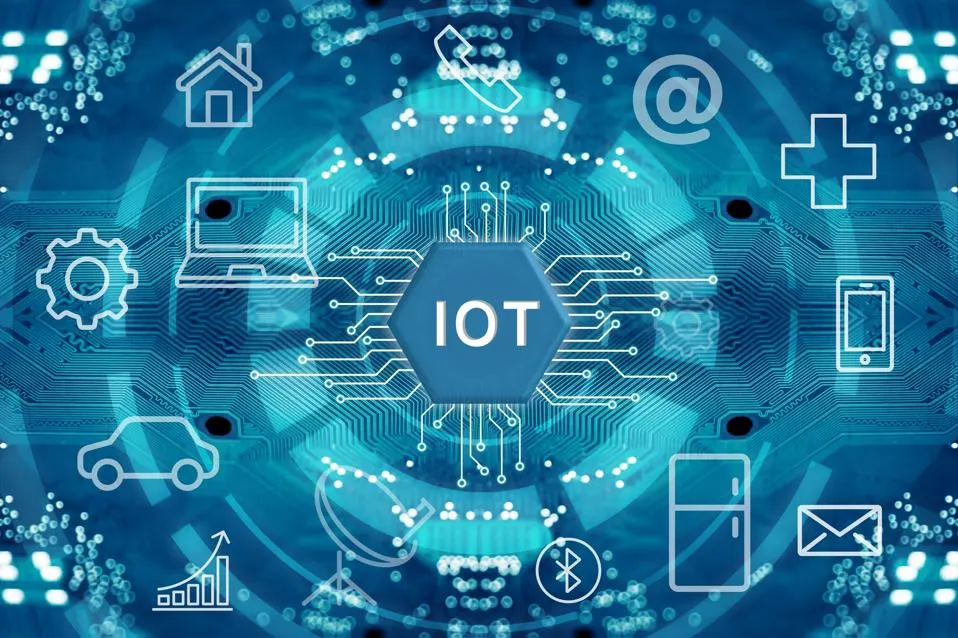
How Does The Internet of Things Work?
IoT devices will typically use one or more sensors to gather information. The type of sensor and the data it records will depend on the use case. For example, in healthcare one example of IoT use is an electrocardiogram array that records a patient’s sinus rhythm and heart rate.
You then have a software layer that provides data analytics and turns that raw sensor data it into something useful. In the electrocardiogram example, the software would look for signs of arrhythmia, an indicator of an underlying health issue.
Why is IoT important?
Improved efficiency
By using IoT devices to automate and optimize processes, businesses can improve efficiency and productivity.
Data-driven decision-making
IoT devices generate vast amounts of data that can be used to make better-informed business decisions and new business models.
Cost-savings
By reducing manual processes and automating repetitive tasks, IoT can help businesses reduce costs and improve profitability.
Enhanced customer experience
By using IoT technology to gather data about customer behavior, businesses can create more personalized and engaging experiences for their customers.
The history of the Internet of Things
Although examples of interconnected electronic devices exist as far back as the early 19th century, with the invention of the telegraph and its ability to transmit information by coded signal over distance, the origins of the IoT date to the late 1960s. It was then that a group of prominent researchers began exploring ways to connect computers and systems. A prime example of this work was ARPANET, the network created by the Advanced Research Projects Agency (ARPA) of the U.S. Defense Department; this network was a forerunner of today’s Internet.
In the late 1970s businesses, governments, and consumers began exploring ways to connect personal computers (PCs) and other machines to one another. By the 1980s local area networks (LANs) provided an effective and widely used way to communicate and share documents, data, and other information across a group of PCs in real time.
Types of IoT
The networking, communication and connectivity protocols depend largely on the specific IoT application deployed. Just as there are many different IoT devices, there are many types of IoT applications based on their usage. Here are some of the most common ones:
- Consumer IoT – Primarily for everyday use. Eg: home appliances, voice assistance, and light fixtures.
- Commercial IoT – Primarily used in the healthcare and transport industries. Eg: smart pacemakers and monitoring systems.
- Military Things – Primarily used for the application of IoT technologies in the military field. Eg: surveillance robots and human-wearable biometrics for combat.
- Industrial Internet of Things – Primarily used with industrial applications, such as in the manufacturing and energy sectors. Eg: Digital control systems, smart agriculture and industrial big data.
- Infrastructure IoT – Primarily used for connectivity in smart cities. Eg: infrastructure sensors and management systems.
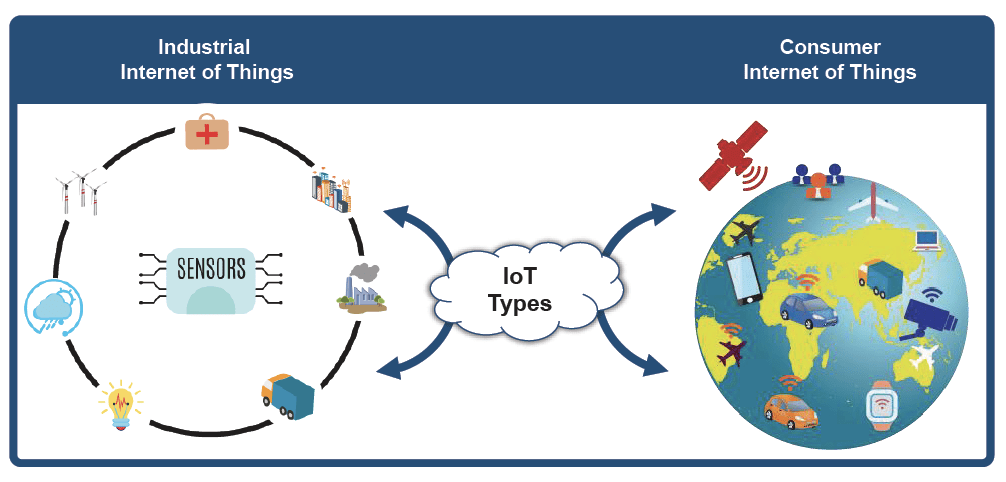
Advantages of the Internet of Things (IoT)
The Internet of Things (IoT) has revolutionized the way we live and work. By connecting physical devices to the internet, IoT offers a multitude of benefits across various sectors. Here are some of the key advantages:
For Individuals
- Convenience and Comfort:
- Smart homes: Automated lighting, temperature control, and security systems.
- Wearable devices: Fitness tracking, health monitoring, and smartwatches.
- Remote control: Managing appliances and devices from anywhere.
- Improved Safety:
- Home security systems: Real-time monitoring and alerts.
- Vehicle safety: Advanced driver assistance systems and emergency response.
- Personal safety: Wearable devices for location tracking and emergency alerts.
For Businesses
- Increased Efficiency:
- Supply chain optimization: Real-time tracking of inventory and shipments.
- Predictive maintenance: Preventing equipment failures through data analysis.
- Automation: Streamlining processes and reducing labor costs.
- Cost Reduction:
- Energy efficiency: Optimizing energy consumption through smart devices.
- Reduced waste: Efficient inventory management and resource utilization.
Overall Benefits
- Enhanced Productivity: Automation and data-driven insights lead to increased productivity.
- Improved Quality of Life: IoT solutions can enhance comfort, safety, and convenience.
- Economic Growth: IoT drives innovation and creates new business opportunities.
Disadvantages of the Internet of Things (IoT)
Security and Privacy Concerns
- Vulnerable Devices: IoT devices often have weak security features, making them targets for hackers.
- Data Privacy: The vast amount of data collected by IoT devices raises concerns about privacy breaches.
- Unauthorized Access: Malicious actors can exploit vulnerabilities to gain unauthorized access to sensitive information.
Complexity and Cost
- Integration Challenges: Integrating various IoT devices and systems can be complex and time-consuming.
- High Initial Costs: Implementing IoT infrastructure requires significant upfront investment.
- Maintenance and Updates: Ongoing maintenance and software updates can be costly and resource-intensive.
Dependency and Reliability
- Network Reliance: IoT devices heavily rely on internet connectivity, which can be unreliable in some areas.
- System Failures: Failures in IoT devices or networks can disrupt operations and cause significant losses.
- Job Displacement: Automation enabled by IoT can lead to job losses in certain sectors.
Environmental Impact
- E-waste: The rapid replacement of IoT devices contributes to electronic waste.
- Energy Consumption: IoT devices consume energy, which can impact the environment.
The technologies that make IoT possible
Several technologies come together to make IoT possible.
- Sensors and actuators: Sensors are devices that can detect changes in the environment, such as temperature, humidity, light, motion, or pressure. Actuators are devices that can cause physical changes in the environment, such as opening or closing a valve or turning on a motor. These devices are at the heart of IoT, as they allow machines and devices to interact with the physical world.
Connectivity technologies: To transmit IoT data from sensors and actuators to the cloud, IoT devices need to be connected to the internet. There are several connectivity technologies that are used in IoT, including wifi, Bluetooth, cellular, Zigbee, and LoRaWAN.
Cloud computing: The cloud is where the vast amounts of data that is generated by IoT devices are stored, processed, and analyzed. Cloud computing platforms provide the infrastructure and tools that are needed to store and analyze this data, as well as to build and deploy IoT applications.
Big data analytics: To make sense of the vast amounts of data generated by IoT devices, businesses need to use advanced analytics tools to extract insights and identify patterns. These tools can include machine learning algorithms, data visualization tools and predictive analytics models.
Security and privacy technologies: As IoT deployments become more widespread, IoT security and privacy become increasingly important. Technologies such as encryption, access controls and intrusion detection systems are used to protect IoT devices and the data they generate from cyberthreats.
What Are The Challenges of The Internet of Things?
The IoT, while promising immense potential, is not without its challenges.
Security and Privacy
- Vulnerable Devices: Many IoT devices have weak security measures, making them easy targets for hackers.
- Data Privacy: The vast amount of data collected by IoT devices raises concerns about privacy breaches.
- Unauthorized Access: Malicious actors can exploit vulnerabilities to gain unauthorized access to sensitive information.
Interoperability
- Standardization: Lack of common standards for IoT devices and protocols hinders seamless integration.
- Compatibility Issues: Different devices and systems often struggle to communicate and share data effectively.
Scalability
- Massive Data: IoT generates enormous amounts of data, which can be challenging to process and analyze efficiently. Network Capacity: The increasing number of IoT devices can strain network infrastructure.
Data Management and Analytics
- Data Quality: Ensuring the accuracy and reliability of IoT data is crucial but challenging.
- Data Storage: Storing vast amounts of IoT data requires efficient and cost-effective solutions.
- Data Analysis: Extracting meaningful insights from IoT data demands advanced analytics capabilities.
Power Management
- Battery Life: Many IoT devices operate on batteries, requiring efficient power management.
- Energy Efficiency: Balancing performance with energy consumption is essential for long-term operation.
Regulatory Compliance
- Complex Regulations: IoT devices often fall under multiple regulatory frameworks, making compliance difficult.
- Data Protection Laws: Adhering to data privacy and protection regulations is essential.
Cost
- High Initial Investment: Implementing IoT solutions can be expensive due to hardware, software, and infrastructure costs.
- Ongoing Expenses: Maintaining and updating IoT systems requires continuous investment.
Talent Shortage
- Skilled Professionals: There is a shortage of professionals with expertise in IoT development, deployment, and management
How should businesses approach IoT?
Managing IoT devices can be a complex and challenging task, but there are several best practices that businesses can follow to ensure that their IoT devices are secure, reliable, and optimized for performance. Here are some tips for managing IoT devices:
Plan your IoT strategy: Before deploying any IoT devices, businesses should have a clear understanding of their objectives, use cases and desired outcomes. This can help them choose the right devices, IoT platforms and technologies, and ensure that their IoT strategy is aligned with their business goals.
Choose secure IoT products: Security is a critical consideration for IoT solutions, as they can be vulnerable to cyberattacks. Businesses should choose devices that are designed with security in mind and implement appropriate security systems, such as encryption, authentication, and access controls.
Monitor and maintain devices: IoT devices need to be monitored and maintained regularly to ensure that they are performing optimally and are not vulnerable to security threats. This can involve monitoring device health and performance, updating firmware and software and conducting regular security audits and predictive maintenance.
Manage data effectively: IoT devices generate vast amounts of real-world data, which can be challenging to manage and analyze. Businesses should have a clear data management strategy in place, including data storage, analysis, and visualization. To ensure that they can extract meaningful insights from the data that is generated by their IoT devices.
Build an ecosystem: IoT devices are often part of a larger ecosystem that includes other devices, platforms, and technologies. Businesses should have a clear understanding of this ecosystem and ensure that their IoT devices can integrate effectively with other systems and technologies.
Unlimited Possibilities with IoT
oT is really just getting started and the estimations for the future growth of IoT devices are at the high end of the scale. In the next few years, we will be connected in ways that are deemed impossible today. The integration of AI and IoT will enable creative thinking and innovative applications across multiple industries.
What Are IoT Devices?
IoT devices are hardware devices, such as sensors, gadgets, appliances and other machines that collect and exchange data over the Internet.
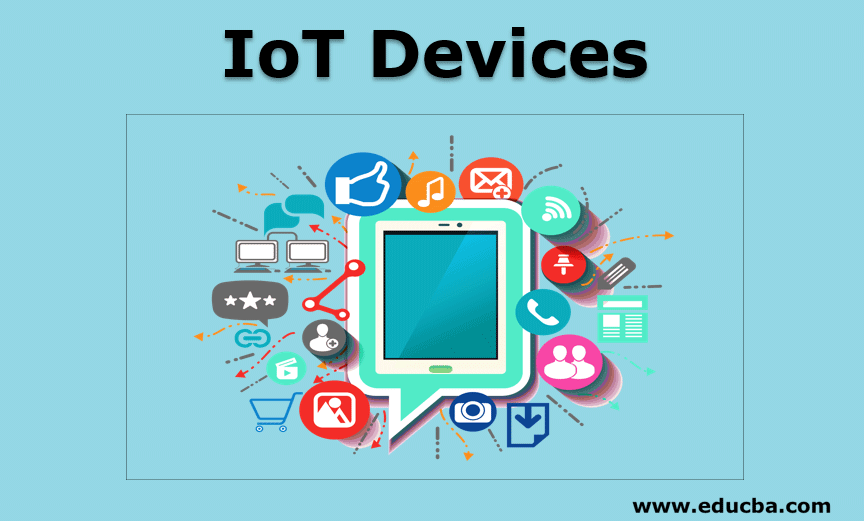
How do IoT Devices Work?
Different IoT devices have different functions, but they all have similarities in terms of how they work. Firstly, IoT devices are physical objects that sense things going on in the physical world. They contain an integrated CPU, network adapter and firmware, and are usually connected to a Dynamic Host Configuration Protocol server. It also requires an IP address to function over the network.
The future of IoT
The future of IoT is promising, with many exciting developments for businesses on the horizon.
- Growth: The number of IoT devices is expected to continue to grow rapidly, with estimates suggesting that there will be tens of billion IoT devices in use over the next few years.
- Edge computing: Edge computing is becoming increasingly important for IoT, as it allows data to be processed and analyzed closer to the source of the data, rather than in a centralized data center.
- Artificial intelligence and machine learning: AI and machine learning are becoming increasingly important for IoT, as they can be used to analyze vast amounts of data that is generated by IoT devices and extract meaningful insights.
- Blockchain: Blockchain technology is being explored as a way to improve security and privacy in the IoT. Blockchain can be used to create secure, decentralized networks for IoT devices, which can minimize data security vulnerabilities.
- Sustainability: Sustainability is becoming an increasingly important consideration for IoT, as businesses look for ways to reduce their environmental impact. IoT can be used to optimize energy usage, reduce waste and improve sustainability across a range of industries.
Examples of IoT Devices
Home Security
The key driver behind smart and secure homes is IoT. A variety of sensors, lights, alarms and cameras (all of which can be controlled from a smartphone) are connected via IoT to provide 24×7 security.
Activity Trackers
Smart home security cameras provide alerts and peace of mind. Activity trackers are sensor devices that can monitor and transmit key health indicators in real-time. You can track and manage your blood pressure, appetite, physical movement and oxygen levels.
Industrial Security and Safety
IoT-enabled detection systems, sensors and cameras can be placed in restricted areas to detect trespassers. They can also identify pressure buildups and small leaks of hazardous chemicals and fix them before they become serious problems.
Augmented Reality Glasses
Augmented Reality (AR) glasses are wearable computer-enabled glasses that help you get extra information such as 3D animations and videos to the user’s real-world scenes. The information is presented within the lenses of the glasses and can help users access Internet applications.
Motion Detection
Motion sensors can detect vibrations in buildings, bridges, dams and other large-scale structures. These devices can identify anomalies and disturbances in the structures that could lead to catastrophic failures. They can also be used in areas susceptible to floods, landslides, and earthquakes.
How safe are your IoT devices?
Since IoT involves such a large framework of interconnected devices it is bound to face a lot of challenges. One of the biggest challenges involves the communication of these devices. Device communication involves risks such as safety and security.
Since IoT standards are not universal, protocols and management vary hugely in different applications of IoT. The lack of common standards in IoT gives rise to security threats in the entire process.
Best Practices for IoT
mplementing IoT successfully requires a comprehensive approach that considers various aspects.
Security First
- Prioritize security from the outset: Incorporate security measures into the design and development phase.
- Regular updates: Keep device firmware and software up-to-date with the latest security patches.
- Strong authentication: Implement robust authentication mechanisms, such as multi-factor authentication.
- Data encryption: Protect sensitive data with strong encryption algorithms.
- Access control: Limit access to IoT systems and data to authorized personnel.
- Incident response plan: Develop a comprehensive plan to address security incidents.
Design and Development
- Clear requirements: Define clear project objectives and user needs.
- Modular architecture: Design scalable and flexible IoT solutions.
- Power efficiency: Optimize power consumption for battery-powered devices.
- Interoperability: Adhere to industry standards for seamless integration.
- Data management: Plan for efficient data collection, storage, and analysis.
Deployment and Management
- Pilot testing: Conduct thorough testing before full-scale deployment.
- Continuous monitoring: Track device performance and network health.
- Remote management: Enable remote configuration and troubleshooting.
- Data analytics: Utilize data insights to optimize system performance.
- Scalability: Design for future growth and expansion.
User Experience
- User-centric design: Create intuitive and user-friendly interfaces.
- Privacy considerations: Respect user privacy and data protection.
- Clear communication: Provide clear instructions and support.
Additional Considerations
- Ethical implications: Consider the ethical aspects of IoT applications.
- Regulatory compliance: Adhere to relevant laws and regulations.
- Sustainability: Minimize the environmental impact of IoT devices.
IoT standards and frameworks
Notable organizations involved in the development of IoT standards include the following:
- International Electrotechnical Commission.
- Institute of Electrical and Electronics Engineers
- Industrial Internet Consortium.
- Open Connectivity Foundation.
- Thread Group.
- Connectivity Standards Alliance.
- IPv6 over Low-Power Wireless Personal Area Networks (6LoWPAN) is an open standard defined by the Internet Engineering Task Force .This standard lets any low-power radio communicate with the internet, including 804.15.4, Bluetooth Low Energy and Z-Wave for home automation
- Zigbee is a low-power, low-data rate wireless network used mainly in home and industrial settings. ZigBee is based on the IEEE 802.15.4 standard. The ZigBee Alliance created Dot dot, the universal language for IoT that enables smart objects to work securely on any network and understand each other.
- Data Distribution Service (DDS) was developed by the Object Management Group and is an IIoT standard for real-time, scalable and high-performance machine-to-machine communication.
Security, privacy, and safety concerns about the Internet of Things
A major concern for the IoT is the ability to build in adequate security protections. Hackers have already breached video systems, Internet-enabled baby monitors, medical devices, and even automobiles, and they have broken into corporate networks via unprotected IoT devices.
Data privacy and personal privacy are also important considerations. Inadequate security can lead to lost, stolen, or incorrectly used data, including private health and financial information. Connected devices and systems—along with data stored in the cloud—increase the number of vulnerability points..
Also that year, criminals broke into a casino, stealing a large amount of data, through an inadequately protected “smart” fish tank, whose Internet capabilities allowed its temperature, salinity, and food distribution to be controlled remotely but which also left the casino’s data system vulnerable to attack.
Why do connected devices need to share data?
An argument has been raised that only because something can be connected to the internet doesn’t mean it should be, but each device collects data for a specific purpose that may be useful to a buyer and impact the wider economy.
Within industrial applications, sensors on product lines can increase efficiency and cut down on waste. One study estimates 35 per cent of US manufacturers are using data from smart sensors within their set-ups already. US firm Concrete Sensors has created a device that can be inserted into concrete to provide data on the material’s condition, for instance.
Top IoT Projects for 2024
- Smart Mirror
- Smart Money Transfer
- IoT based Smart arm
- Smart Irrigation
- Smart Door
- Air Monitoring System
- Smart Alarm Clock
- IoT based Weather Reporting System
- Smart Wheelchair
- Smart Street Light System
Smart Mirror
How are you reading this video right now? It might be on your smartphone, desktop, or tablet. Connecting devices to the Internet yields fantastic benefits. But what is the Internet of Things?
In a nutshell, IoT is the concept of connecting any device to the internet and other connected devices. All instruments in the network interact with each other to collect and share data. Today, IoT is being used extensively to lessen the burden on humans. To name a few, IoT is deployed for Smart homes, Wearables (watches and bracelets), Smart Cars, Smart farming, Smart Retail, Smart Grids, Smart city, and smart healthcare.
With such a broad spectrum of applications, the future of IoT looks more promising than ever before. In this internet of things projects article, we bring you the top IoT projects of 2020. If you are a student, you could consider them for academic purposes or implement these purely out of interest.
Explore the most innovative IoT projects for 2024 with our all-inclusive guide! Our carefully chosen collection of projects highlights the most recent advancements in Internet of Things technology, ranging from industrial monitoring systems to smart home automation. Enroll in our Java course to gain the skills necessary for building amazing projects using the Java programming language and confidently explore the world of networked devices. With the help of our expert advice, realize your ideas and unleash the potential of IoT.
Now that you know what the Internet of Things is, continue reading to learn some easy yet exciting Internet of Things projects.
Top IoT Projects for 2024
- Smart Mirror
- Smart Money Transfer
- IoT based Smart arm
- Smart Irrigation
- Smart Door
- Air Monitoring System
- Smart Alarm Clock
- IoT based Weather Reporting System
- Smart Wheelchair
- Smart Street Light System
- Smart Agriculture System
- Home Automation System
- Face Recognition Bot
- Air Pollution Monitoring System
- Smart Parking System Project
- Smart Cradle System Project
- Smart Gas Leakage Detector Bot
- Liquid Level Monitoring System
- Night Patrol Robot
- Health Monitoring System
Smart Mirror
We will now look at the first IoT project, the Smart mirrors. Smart mirrors are a very cool IoT application. It can be used to display the temperature, news, weather, calendar, clock, and compliments on a mirror. Apart from these, smart mirrors can be used for the following.
- Click the perfect selfies with a built-in camera.
- Installed with speakers to play some music and provide on-demand workout sessions from world-class trainers.
- Browse the internet, make phone calls, and even be connected with other devices for collaboration.

Smart Money Transfer
The next internet of things project is the Smart Money Transfer. We’re heading towards complete digitization. Transactions are made possible on your cell phone with apps like Apple pay, Google Pay, and Paypal.
- Provides a comfortable and reliable platform for money transactions.
- It is compact, wearable, and rechargeable.
- For safety purposes, user authenticity is validated.
- This technology can reduce the burden of mobile money transfers.

IoT based Smart Arm
This IoT project includes creating a robotic arm that can pick and place things from one place to another. To control this action, the robotic arm can be moved using specific commands. Some advanced arms allow the user to change the end effect of the arm to perform various actions. It can be used to make art, print 3D images, and build production lines. It can also be used to perform your day to day chores.
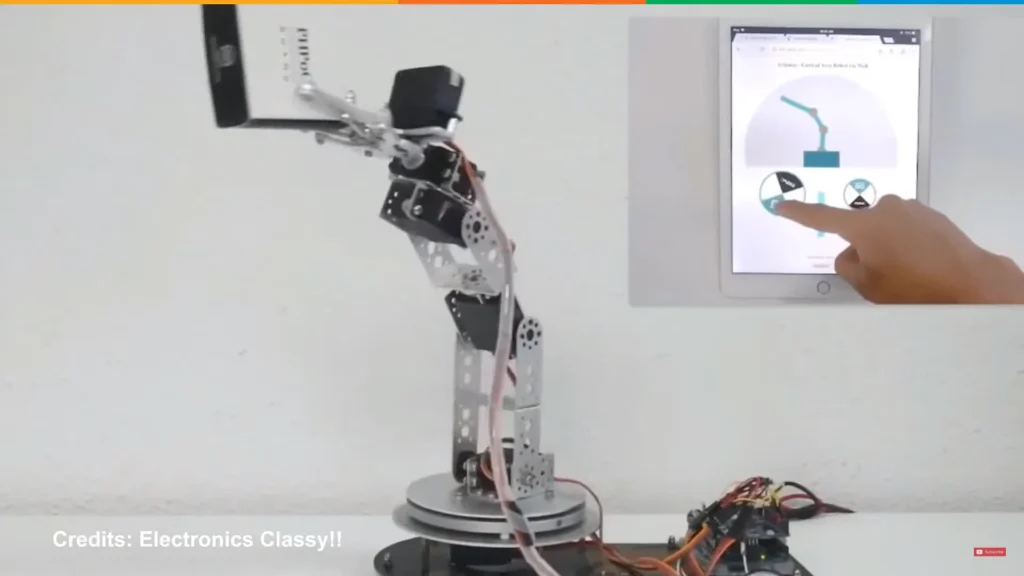
Smart Irrigation
The next IoT project is smart irrigation. With the change in climate and recurrent water crisis, farmers suffer a great deal with growing crops. Smart irrigation puts an end to this ordeal. This system comes with a9 moisture sensor that checks the soil for its water content. When the soil moisture drops below a specific value, the system triggers the water supply.

Smart Door
As the name suggests, this IoT project aims at creating smart doors that control the entry and exit of humans. These doors open and close automatically when you pass by. The door can also be controlled remotely. You could unlock the door for perhaps a friend, by tapping an icon on your smartphone. Once they exit, you’re immediately notified. The owner can also choose who has access to the door.
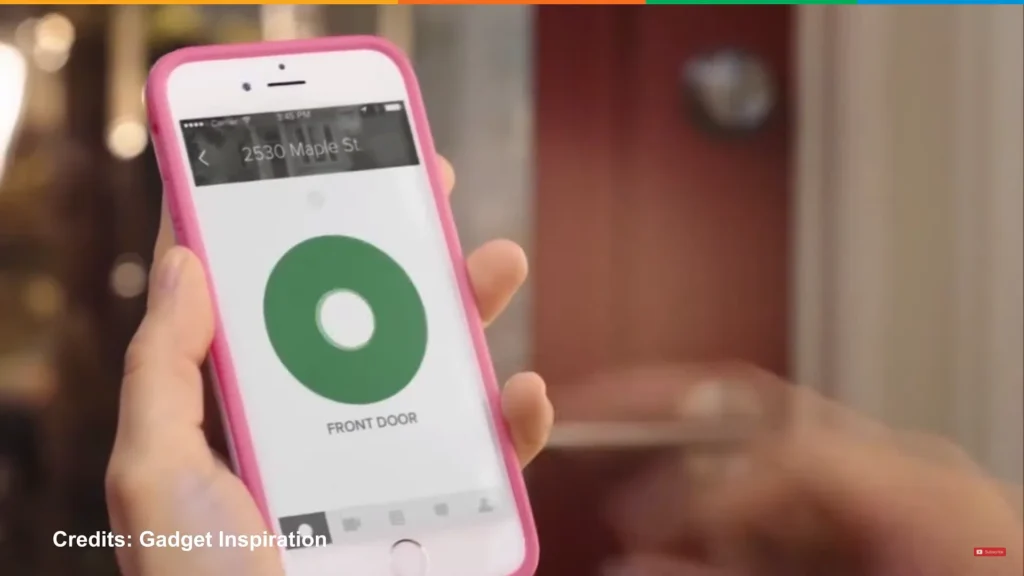
Conclusion
The Internet of Things (IoT) is undeniably transforming our world. By connecting physical devices to the internet, it has the potential to revolutionize industries, enhance our daily lives, and drive economic growth. From smart homes and cities to healthcare and agriculture, IoT applications are vast and promising.
However, the journey towards realizing the full potential of IoT is not without its challenges. Security, privacy, interoperability, and scalability are critical issues that must be addressed to ensure the widespread adoption and acceptance of IoT technologies.
As we move forward, it is imperative to strike a balance between innovation and responsibility. By prioritizing security, protecting user privacy, and fostering collaboration among stakeholders, we can harness the power of IoT to create a more connected, efficient, and sustainable future.
Ultimately, the success of IoT will depend on our ability to address its challenges and leverage its opportunities in a responsible and ethical manner.
FAQS
For example, IoT sensors can be used to monitor equipment performance and detect or even resolve potential issues before they cause downtime, reducing maintenance costs and improving uptime. IoT devices generate vast amounts of data that can be used to make better-informed business decisions and new business models.
The internet of things is a technology that allows us to add a device to an inert object (for example: vehicles, plant electronic systems, roofs, lighting, etc.) that can measure environmental parameters, generate associated data and transmit them through a communications network.